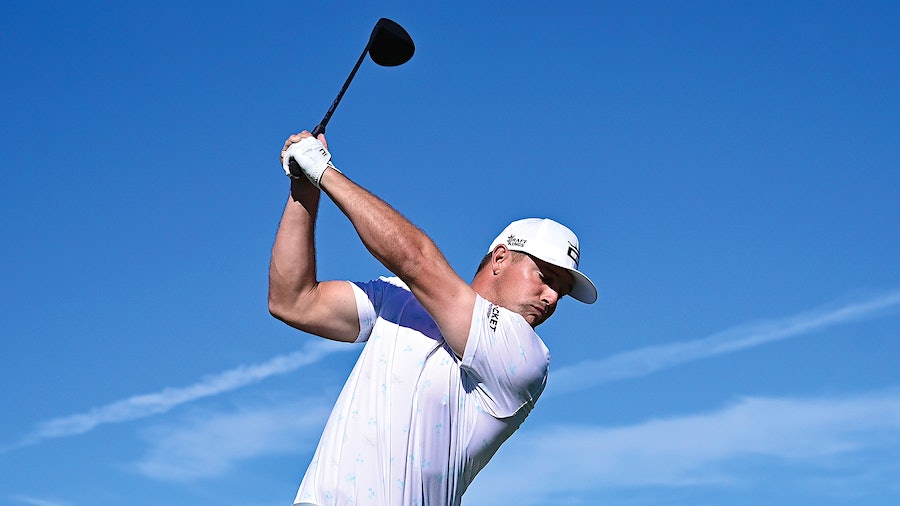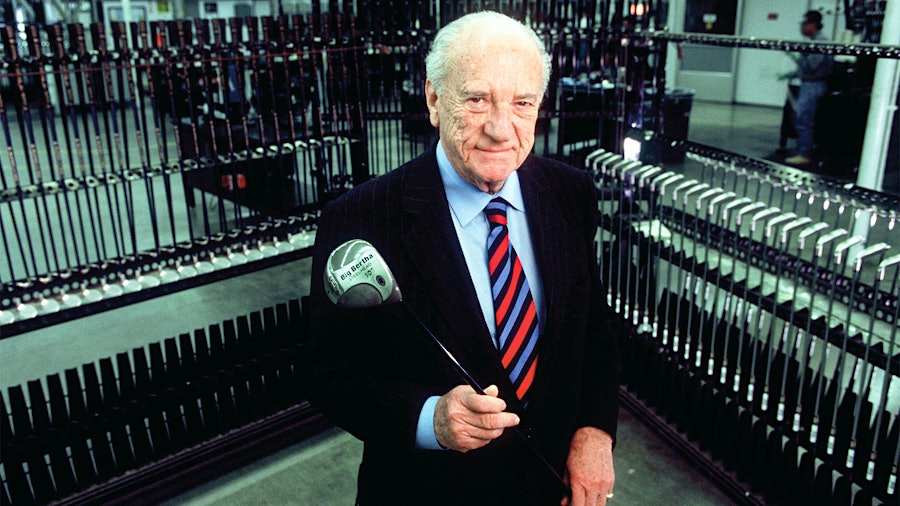Drive For Show

No club in a golf bag provides more excitement, more exhilaration, more exclamation points to a player’s game than the driver. It’s your own personal blunderbuss, your hammer of Thor, your bolt of lightning that you can wield against your Saturday foursome or during a weekday pickup game. It’s the ultimate extension of your golfing ego.
After all, the driver is likely to be the club that you use right from the first tee, the club that magnifies your strength, maximizes your satisfaction. Sure, the putter ultimately determines your score, your wedges help save the day and any of the other clubs in your bag can provide a thrill now and then. But let’s face it, when you outdrive your best bud by 20 yards, regardless of the final score, there is a certain smile. And everyone dreams of reaching 300 yards. Maybe, just maybe, there’s hope.
The golf club companies know this. That’s why they invest millions upon millions of dollars in driver technology, looking for newer, lighter, more responsive materials and designs that fuel the driver mantra of “longer, straighter, more forgiving.” Given all of its attention, the driver is also the golf club that has evolved more than any other in the last 40-odd years, morphing from the wooden persimmon drivers (and weren’t some of them just gorgeous?) to the new-age composite material behemoths that we play today.
Those old persimmon driver heads—swung to great effect by Arnold Palmer and Jack Nicklaus and so many other fine players—were around 160 to 175 cubic centimeters. By United States Golf Association and Royal and Ancient Golf Club of St Andrews rules, the modern driver head is limited to 460 cc, along with a whole bunch of other parameters that must be met. And making sure those parameters aren’t stretched means drivers are tested, for they are the clubs that are the most tested of all, the clubs that the USGA keeps a dedicated eye on, as well as the eyes of the PGA Tour and all the other professional tours around the world. And today, players are using these modern drivers to belt it well over 300 yards off the tee on average.
The two biggest golf companies on the planet, TaylorMade and Callaway, rose to visibility and viability on the strength of introducing steel-headed drivers to the world that forever changed the way that golfers looked at teeing off. They weren’t just holding a golf club on the first tee, they were holding a bazooka.
“Without question, the driver has always been and will always be the most exciting club in the bag,” says Dave Abeles, chief executive officer of TaylorMade Golf Co. “It’s the club that goes the furthest, the club that you are constantly striving to hit long and straighter. Every dialogue after every round of golf is like, ‘How far did you hit the driver on No. 5’ or ‘Boy, you hit a great tee shot on No. 12,’ that circulates around the energy driven by the driving distance of the driver.”
Abeles knows a thing or two about the driver, about how it drove the company to greatness. It was club designer Gary Adams, taking a $24,000 loan on his house, who founded TaylorMade, bringing to market in 1979 a driver that would start a revolution in the golf club business, a cast stainless steel driver he dubbed the “Pittsburgh Persimmon.” There had been metal-made predecessors, but none of them moved the needle like this one. Adam’s Pittsburgh Persimmon grabbed the spotlight.
“When TaylorMade and Gary Adams launched the metalwood, and we actually trademarked the name metalwood in 1979, that was a technology made out of cast stainless steel that, over the next 20 years, would replace traditional laminated woods and persimmon woods,” says Abeles. “And it transitioned from I’m playing woods to now I’m playing metalwoods.”
And boy, did the driver world and the golf world transition. Then along came Ely Callaway, who in 1991 brought the spotlight to even bigger stainless steel driver heads that thrust the terms “forgiveness” and “sweet spot” into the golf lexicon with the launch of the Big Bertha. Callaway was golf’s ultimate marketer, something his son Nicholas found out when his father revealed the prototype of the Big Bertha to him in 1990. It was a steel-headed driver, at 190 cc not much bigger than drivers of its day, but it sure looked huge. It had a name derived from a World War I German howitzer and in Callaway it had a promoter who was a fine amateur player and successful businessman who was never shy about ballyhooing his wares. After selling his wine business for a substantial profit, Callaway bought into a novelty golf club company called Hickory Sticks. It was the seed of what would become a golf giant.
In early 1991, Nicholas Callaway met his father at the Del Mar Country Club in Southern California for a round of golf, as they usually did, but this would be no usual round. “He would always bring prototypes of clubs when we played together at the Del Mar Country Club,” says Nicholas. “Big bag of prototypes, and he always kept them under a towel to keep them hidden. He pulled the club out.”
“Nicky, you see this club?” Ely told his son. “A year from now this is going to be the biggest-selling golf club in the world and it’s going to change the golf industry and the game of golf.”
Nicholas didn’t believe it. “Because he was making these Hickory Sticks, I was skeptical and didn’t take him very seriously which was my mistake,” says Nicholas. Then Ely told him the name. “I’m going to call it the Big Bertha,” Ely said.
“I said, ‘I think it’s the worst name for a product I ever heard,’ ” replied Nicholas.
“Well, you’re wrong and let me tell you why you are wrong,” Ely told his son. “First of all because it has a great story, and every product should have a story.” He then went on to talk about the German gun that inspired the name. “That was the story and he loved to tell stories,” says Nicholas. “Then he explained the technology of an oversized golf club head, the principle of increasing the sweet spot. He said I can’t guarantee I can make you a better golfer but I can help you enjoy the game more because the driver is the most intimidating club in the bag. We’re going to make it easier.”
Nicholas wasn’t convinced, so his father handed him the club for him to take it for a test drive. “So I addressed the ball, and I hit it and it made a very strange sound. I looked down and the ball had dribbled off the tee and the club head separated from the shaft and had flung farther than the ball by 20 yards.”
Ely wasn’t disappointed. “Don’t worry about that,” he said. “We have a few gluing problems but we are going to figure it out and I promise you it’s going to change the game of golf.”
Of course, the father was correct, and the Big Bertha became a runaway hit. “It shows his vision. He understood the average golfer, he understood product innovation and boy, did he understand marketing,” says Nicholas. “Back then the Big Bertha was the biggest thing you had ever seen. Now it looks tiny.”
It was oh, so big.
Through the 1980s and into the ’90s TaylorMade was making great strides itself with different and larger iterations of metalwoods and Curtis Strange won the 1988 U.S. Open using one of them. With Callaway’s Big Bertha the heads kept getting bigger and bigger (Great Big Bertha and the Biggest Big Bertha followed) and the large club companies jumped into the fray. With TaylorMade and Callaway leading the way, Mizuno, Titleist, Ping, Cobra and MacGregor all fought for a piece of the growing driver market, and Mizuno launched the age of titanium with the Ti-110 in 1990, the first driver to use the light (but considerably strong) alloy. Titanium eventually took over the whole driver head industry along with companion carbon fiber composites.
The new materials and technology supplanted steel and brought a whole new dimension (and attention) to the role of the driver. Heads of more than 400 ccs with titanium faces—providing what became known as the “trampoline effect”—were launching balls unprecedented distances with unprecedented forgiveness, a cause for concern at the USGA, the governing body of the sport in the United States, which felt that skill was giving way to technology at the professional and elite amateur ranks of the game. Eventually, new rules would govern the size of the head, set at a maximum of 460 ccs along with rules as to how big a head could be. And the trampoline effect of the face would be limited.
Other innovations followed. TaylorMade introduced its Quad 7 driver in 2005 with adjustable weight technology, and other companies followed suit. The drivers could be mechanically adjusted for weight distribution, allowing for different launch angles and for draw or fade bias. Of course, rules came into play that governed the adjustability factor as well. Shafts were getting longer and lighter, upwards of 48 inches from what had been a standard 43 inches for drivers for most of the 20th century. The physics of the longer shaft increased the power of hits, though they did demand a great deal of practice to keep under control.
And—you guessed it again—the USGA has put into play a new rule that allows various governing bodies to limit the length of shafts to 46 inches, a rule that basically is aimed at tournament play. The USGA said the new limit will apply to all 14 USGA championships.
The USGA’s John Spitzer insists that his organization is not trying to take fun and innovation out of the game, just trying to make sure that skill is the overriding factor in playing the game, and that starts with the driver. “They are the single club that requires the most testing,” says Spitzer, the USGA’s managing director of equipment standards. “We are not all looking to stifle innovation. While we don’t want to obsolete golf courses, we don’t want in any way to stifle innovation and take fun out of the game. That is not our job. Our job is to protect the game.”
Monitoring driver technology is complicated. “We have a moment of inertia which is resistance to twist, we put the clubhead on a machine to measure the moment of inertia on that,” says Spitzer. They also look at head size, where the shaft attaches to the club, and other details as well, but the biggest thing they look for is that trampoline effect. “Probably the single most important thing from the standpoint of performance is we measure the spring-like (trampoline) effect,” he says.
Just as the governing bodies go on and on to try to ensure modern drivers don’t make the game unfair, so, too, does the effort of club companies to sell you an even better version of their drivers. This year, TaylorMade brought to market a driver it calls Stealth, first played in competition by someone who has a thing for drivers—Tiger Woods. Woods used it during his striking comeback from a devastating car crash in February 2021, playing with his son Charlie in the PNC Championship in December.
The club, based on a 60-ply carbon fiber face insert instead of titanium, will essentially end the metalwood era, according to TaylorMade’s Abeles. His company has put 20 years of highly confidential research into the carbonwood technology, hence the name Stealth.
“We believe with the launch of the new Stealth technology we are essentially retiring the concept of a metalwood,” says Abeles. “We will never make in our core inline drivers a metalwood again. We are making carbonwoods. We are out of the metalwood business. We are in the carbonwood business now.”
Abeles says his company is driven by innovation to advance the game via technology. “Our company lives by the motto that if we can’t bring a product to market which is better in form, which is the design of the product, and function, which is the physical performance of the product, we won’t launch it,” says Abeles. “So for 20 years we’ve been working on finding a new material composition that would outperform traditional titanium faces. We got to the point where we don’t believe that the use of titanium in face technology in drivers can go any further. It was time to make the change. Now we are seeing material improvements, no pun intended, physical performance improvement at every skill level in golf through this new face technology called Stealth.”
Of course, all companies are trying to do the same thing. The driver tends to be the flagship club of any company’s line, a lightning rod that brings a flash of energy to an entire line of clubs and accessories. And with drivers selling from $300 to $700, there is a bunch of profit down the line.
Matt Neeley is the vice president of product development of the TourEdge Golf Co., founded in 1986 at the relative beginning of golf’s technology age. For Neeley, the driver always has the honor when it comes to equipment development.
“The driver is the most notable of all the clubs that make up the 14 in the bag,” says Neeley. “It’s probably the one that people pay the most attention to. We find it is the one that is replaced the most.
“Quite often when we start out with a product line, we start out with the design of the driver. It’s also our biggest canvas to work on. We can apply the most art work to it, put the biggest weights on it, we can do the most design and engineering work on the driver and let the technologies and the features we are able to put on the driver trickle down into the rest of the lineup, the fairways and the hybrids. The driver is the leading product we focus on.”
Stephanie Luttrell is director of Titleist metalwood development for that iconic golf brand. She’s been reaching into space to gain an edge on her TSI line of drivers.
“On TSI we have a new face material that’s never been used in golf before called ATI 425 which has incredible strength and toughness properties that have allowed us to thin that face further for more off-center ball speed and distance consistency to all of the players,” says Luttrell. “It’s a new titanium, a U.S. alloy. It has been used in the Mars Rover Program. Never been used in golf before.”
For the relatively new PXG Golf Co., which started by producing a line of irons, the driver now has taken a key role. “The driver is incredibly important to consumers; it sets up the hole for the player and equally important for a brand because it’s one of the more exciting clubs, one that players change maybe more often than other clubs,” says chief product officer Brad Schweigert.
Bob Parsons is the founder of PXG, and his raspy upbeat voice narrates the company’s extensive television advertising campaign. You may have noted at the start of the year that he was hawking his new Gen 4 driver with a price point of $299, on the lower end of the scale of big-headed drivers.
As to the importance of the driver to the game, Parsons could easily be talking for the entire industry with the final words of the commercial: “Kaboom, Baby.”







